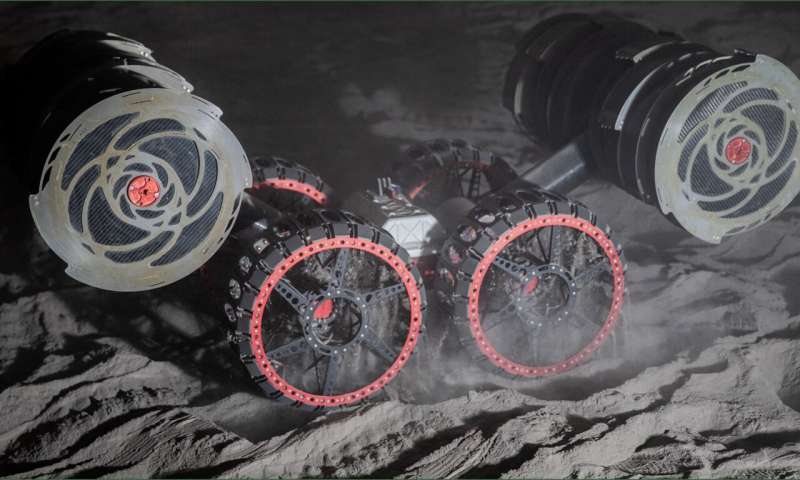This article has been reviewed according to Science X's editorial process and policies. Editors have highlighted the following attributes while ensuring the content's credibility:
fact-checked
trusted source
proofread
What type of excavator is most suitable for asteroids?

Digging in the ground is so commonplace on Earth that we hardly ever think of it as hard. But doing so in space is an entirely different proposition. On some larger worlds, like the moon or Mars, it would be broadly similar to how digging is done on Earth. But their "milligravity" would make the digging experience quite different on the millions of asteroids in our solar system.
Given the potential economic impact of asteroid mining, there have been plenty of suggested methods on how to dig on an asteroid, and a team from the University of Arizona has published the latest in a series of papers about using a customized bucket wheel to do so.
Bucket wheel designs seem to be gaining popularity in space mining more generally lately. NASA's ISRU Pilot Excavator (IPEx) uses a similar design and has been advanced to Technology Readiness Level 5, according to its latest yearly report. However, it was designed for use on the moon, where gravity is significantly larger than that of the asteroids that hold vastly more valuable materials.
According to the paper, the lowest 10% of asteroids have higher concentrations of platinum group metals, such as palladium and osmium, than the moon does. They are also much more "energy accessible," meaning that you would only need a delta-V of about 5% that of the moon to get resources off an asteroid undergoing active mining.
Since delta-V is equivalent to fuel weight and is therefore directly equivalent to cost, lower delta-V makes mining on these tiny bodies much more economically attractive.
But they have their own engineering challenges to face. Most asteroids are known as "rubble piles," meaning they are made up of clumps of rock simply stuck together by whatever minimal gravity their mass gives them. Even metal-rich M-type asteroids, such as Psyche, could be primarily composed of these small chunks of material. Such an environment would not be very hospitable to traditional mining techniques.
The University of Arizona researchers, led by Dr. Jekan Thangavelautham, have taken a rapid iteration approach to solving that problem. They developed a model representing the forces expected on the surface of an asteroid and applied those forces to models of different bucket wheel designs, selecting features that best suit the environment.
They also took the next step and started 3D printing prototypes of the different designs. They intended to use those printed prototypes to collect physical data on the mechanics of excavation; however, to do so, they needed realistic asteroid regolith simulant material.
That doesn't currently exist, so they decided to make their own. A combination of styrofoam and 3D-printed resin seemed to do the trick, however they weren't able to make enough simulant yet to test a planned test assembly for this paper thoroughly.
One of the other important findings of the paper was the impact different characteristics of the asteroid itself would have on two of the most important parameters for the design—the bucket volume and the cutting velocity (i.e., how fast the buckets move). Some characteristics, such as the resource concentration, had little impact on those two parameters. However, other obvious ones, such as the density, had a major impact.
The research team found that high-volume, slow-moving buckets were ideal in this environment. However, part of that consideration was how quickly an orbiting support craft would fill up with material being excavated. To increase the throughput time of material from the bucket wheel to the storage system, the researchers suggest the use of a screw feeder, which would also allow the bucket to operate continuously—another necessity given the economic constraints of the system.
Additionally, they found that claws were necessary to hold onto the regolith. An extensible tubing system is also a "nice-to-have," though it becomes more necessary if there are many buckets per wheel.
Details of this work are contained in the paper, and an associated presentation was given by the researchers at the ASCEND conference at the end of July.
While these milestones are a step in the right direction, these technologies are still at a relatively low readiness level. However, they will eventually be needed if humans utilize some of the most easily accessible resources in the solar system. As our expansion to other worlds picks up, it's only a matter of time before a bucket excavator lands on an asteroid and starts going to work.
More information: Paper: Modified Bucket Wheel Design and Mining Techniques for Asteroid Mining
Provided by Universe Today




















